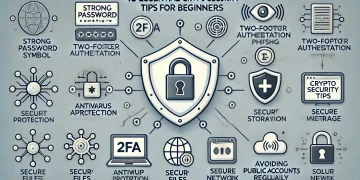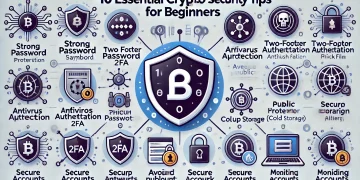Cryptocurrency trading has surged in popularity over the past decade, with day trading becoming one of the most active and exciting ways to engage with digital assets. Unlike traditional markets that have limited trading hours, the crypto market operates 24/7, providing traders with the opportunity to make profits at any time. However, day trading crypto comes with significant risks and requires a deep understanding of market dynamics, technical analysis, and effective strategies.
This comprehensive guide will explore the key concepts behind crypto day trading, tips for success, potential pitfalls, and strategies to help both beginners and experienced traders navigate the fast-paced and volatile world of cryptocurrency trading.
1. What is Day Trading in Crypto?
Day trading involves buying and selling financial instruments, such as cryptocurrencies, within a single trading day. The goal is to capitalize on short-term price movements in the market. In the context of cryptocurrencies, day traders seek to profit from the extreme volatility and rapid price fluctuations that are common in digital assets like Bitcoin (BTC), Ethereum (ETH), and altcoins.
Unlike long-term investing, where traders buy and hold assets for months or years, day traders focus on short-term market trends, often executing multiple trades within a single day. They rely heavily on technical analysis, chart patterns, and market news to make informed decisions about when to enter or exit a trade.
Key Features of Crypto Day Trading:
- 24/7 Market Access: The crypto market never sleeps, allowing traders to engage in trading at any time of day or night, across different time zones.
- High Volatility: Cryptocurrencies are known for their price volatility, which can lead to significant profits—or losses—within short periods.
- Leverage Trading: Many exchanges offer leverage, enabling traders to borrow capital to increase their positions. While this can amplify profits, it also increases the risk of larger losses.
- Technical Analysis: Day traders use charts, patterns, and technical indicators to predict future price movements and identify profitable trading opportunities.
2. Why People Choose to Day Trade Crypto
Day trading in crypto has attracted a diverse range of participants, from hobbyist traders to full-time professionals. Here are some of the main reasons why people choose to engage in day trading:
1. Profit Potential
The significant price swings in the cryptocurrency market create the potential for large gains in a short amount of time. Unlike traditional stock markets, where price movements are often more gradual, cryptocurrencies can experience double-digit percentage changes within hours or even minutes.
2. 24/7 Market Access
Unlike traditional financial markets that operate on specific schedules (like stock markets with defined trading hours), cryptocurrency markets are open 24/7. This constant availability allows traders to capitalize on market movements at any time, making it ideal for traders who want flexibility.
3. Low Capital Requirements
Crypto day trading does not necessarily require large amounts of capital to start. Many exchanges allow traders to open positions with minimal investment, and some even provide leverage options to magnify potential returns (though this also increases risk).
4. Decentralized and Global
The cryptocurrency market operates without intermediaries like banks or brokers, allowing traders to engage directly with the market from anywhere in the world. This decentralization provides a sense of freedom and autonomy that appeals to many traders.
5. High Liquidity
Many cryptocurrencies, especially major ones like Bitcoin and Ethereum, offer high liquidity, which means there are always buyers and sellers in the market. This makes it easier to enter and exit trades quickly, a key requirement for day trading.
3. The Risks of Day Trading Crypto
While the potential rewards of crypto day trading are enticing, it’s essential to understand the risks involved. The volatile nature of the cryptocurrency market means that while profits can be substantial, losses can also occur rapidly. Here are the main risks that day traders should be aware of:
1. Market Volatility
Cryptocurrencies are highly volatile assets, with prices capable of swinging by 10%, 20%, or even more within a single trading session. While volatility creates opportunities for profit, it also exposes traders to significant risks of loss.
2. Leverage Risk
Many crypto exchanges offer leverage, allowing traders to borrow funds to increase their position sizes. While leverage can magnify gains, it can also amplify losses. A small adverse price movement can result in the liquidation of a leveraged position, wiping out a trader’s capital.
3. Emotional Trading
The fast pace of day trading can lead to emotional decision-making, which is a common downfall for inexperienced traders. Fear of missing out (FOMO), panic selling, and impulsive trading can all result in poor decision-making and significant losses.
4. Liquidity Risk in Smaller Tokens
While major cryptocurrencies like Bitcoin and Ethereum have high liquidity, smaller and lesser-known altcoins may have limited liquidity. This can make it challenging to enter or exit trades without experiencing slippage (a difference between the expected price of a trade and the actual price).
5. Exchange Risks
Crypto exchanges can be vulnerable to hacking, downtime, or liquidity issues, which could result in traders losing their funds or being unable to execute trades at crucial moments. Choosing a reliable and secure exchange is critical for mitigating these risks.
4. How to Get Started with Day Trading Crypto
For those looking to start day trading crypto, it’s essential to approach the market with a well-thought-out strategy and understanding of the basics. Here’s how to get started:
1. Educate Yourself on Cryptocurrencies
Before jumping into trading, familiarize yourself with the crypto market and the specific assets you want to trade. Understanding the technology behind cryptocurrencies, including blockchain and smart contracts, will give you a solid foundation for making informed decisions.
2. Choose a Reliable Crypto Exchange
The exchange you choose will be your gateway to the crypto market, so it’s essential to select a platform that offers low fees, a wide range of coins, and strong security features. Some of the most popular crypto exchanges for day trading include Binance, Coinbase Pro, Kraken, and FTX. Consider factors like liquidity, user interface, and access to advanced trading tools.
3. Set Up a Trading Strategy
A successful day trader has a clear and defined trading strategy that guides their decisions. This could involve trading based on technical analysis, chart patterns, or fundamental news events. Your strategy should outline entry and exit points, risk management, and position sizing.
4. Practice with Paper Trading
Before risking real money, practice your trading strategy with a demo account or paper trading. This allows you to simulate real trades without the risk of losing capital, helping you refine your strategy and build confidence.
5. Manage Your Risk
Day trading is inherently risky, so it’s critical to have a strong risk management plan. This includes setting stop-loss orders to minimize potential losses, determining how much of your capital you are willing to risk on each trade, and avoiding overleveraging your positions.
6. Stay Updated on Market News
Cryptocurrency markets are highly reactive to news events, regulatory announcements, and technological developments. Follow major crypto news outlets and social media channels like Twitter, Reddit, and Telegram to stay informed about the latest market developments that could impact prices.
5. Essential Day Trading Strategies
Day trading strategies typically revolve around identifying short-term trends, capitalizing on small price movements, and maximizing profits while minimizing risks. Below are some of the most popular strategies for crypto day traders:
1. Scalping
Scalping is a day trading strategy that involves making numerous trades throughout the day, aiming to profit from small price changes. Scalpers hold positions for a few seconds or minutes, looking to “scalp” a small profit repeatedly over many trades. This strategy requires significant attention to the market and high liquidity to quickly enter and exit positions.
2. Range Trading
Range trading involves identifying support and resistance levels in a cryptocurrency’s price. Traders buy at the support level (where the price tends to stop falling) and sell at the resistance level (where the price tends to stop rising). This strategy works best in markets that are moving sideways, rather than trending.
3. Trend Following
Trend following is a strategy where traders capitalize on the momentum of an asset’s price movement. Traders will typically enter a trade once a clear upward or downward trend is established and stay in the trade as long as the trend continues. Indicators like Moving Averages or the Relative Strength Index (RSI) can help identify trends.
4. Breakout Trading
Breakout trading involves entering a trade when the price breaks out of a predefined range or chart pattern. A breakout occurs when the price moves above resistance or below support with increased volume. Breakout traders aim to profit from the rapid price movement that typically follows a breakout.
5. News-Based Trading
Given that cryptocurrencies are highly sensitive to news, traders can capitalize on significant events such as regulatory changes, technological advancements, or partnerships. Positive news often leads to price surges, while negative news can trigger sell-offs. The key is reacting quickly to these events and using them as opportunities for short-term trades.
6. Tools and Indicators for Crypto Day Trading
Day trading relies heavily on technical analysis, and several indicators can help traders make better decisions. Here are some of the most common tools used by crypto day traders:
1. Moving Averages
Moving averages smooth out price data to help identify trends over a specified period. The two most common types are the Simple Moving Average (SMA) and the Exponential Moving Average (EMA). Moving averages help traders determine whether the market is trending upward or downward and can also signal potential entry or exit points.
2. Relative Strength Index (RSI)
The RSI is a momentum indicator that measures the speed and change of price movements. It ranges from 0 to 100 and is used to determine whether an asset is overbought or oversold. A reading above 70 indicates that an asset is overbought and may be due for a correction, while a reading below 30 suggests that it’s oversold and may experience a price increase.
3. Bollinger Bands
Bollinger Bands consist of a middle band (SMA) and two outer bands that represent the standard deviations of the asset’s price. When the price touches the upper band, it may indicate an overbought condition, while touching the lower band could signal an oversold condition. Traders use Bollinger Bands to predict future price movements based on volatility.
4. Fibonacci Retracement
Fibonacci retracement levels are used to identify potential support and resistance levels based on the mathematical ratios derived from the Fibonacci sequence. These levels can help traders determine where to enter or exit a trade, particularly when trying to predict reversals in the market.
5. MACD (Moving Average Convergence Divergence)
MACD is a trend-following momentum indicator that shows the relationship between two moving averages of a security’s price. It helps traders identify potential buy or sell signals by looking for crossovers and divergences between the moving averages.
7. Common Pitfalls in Crypto Day Trading
Despite the profit potential, many traders fail in day trading due to common mistakes. Here are some pitfalls to avoid:
1. Overtrading
One of the most common mistakes is overtrading, where traders execute too many trades in a short period. Overtrading can lead to high transaction fees, emotional decision-making, and poor overall performance. It’s crucial to be selective about trades and not act out of boredom or frustration.
2. Lack of Risk Management
Failing to set stop-loss orders or ignoring risk management principles can lead to significant losses. Without a clear plan to manage risk, traders can wipe out their capital in a single bad trade.
3. Chasing Losses
When traders lose money, they may feel compelled to take bigger risks to recover their losses, leading to even more significant losses. It’s essential to remain disciplined and stick to your trading strategy, regardless of recent performance.
4. Neglecting Fees
Transaction fees can quickly add up, especially for day traders who execute multiple trades a day. It’s important to factor in fees when calculating potential profits and ensure that they don’t eat into your returns.
8. Conclusion: Mastering Day Trading in Crypto
Day trading cryptocurrency can be a profitable venture for those who approach it with the right strategy, discipline, and knowledge. However, the volatile and fast-paced nature of the market also makes it one of the most challenging trading strategies to master. By educating yourself, managing your risk, and developing a well-thought-out trading plan, you can increase your chances of success while avoiding common pitfalls.
Remember, day trading is not a get-rich-quick scheme, and consistent profits require patience, dedication, and the ability to adapt to ever-changing market conditions.






























